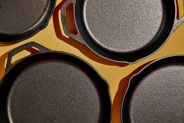Among collectors, conversations about cast iron have a way of getting sentimental, and often land in the same place: the quality of craftsmanship. “Cast-iron pans used to be made by hand,” says Mary Theisen, an enthusiast-turned-businesswoman who travels the country in search of rare and collectible cookware. In 2012, Thiesen founded a site called The Pan Handler, which sells her refurbished cast-iron discoveries for upwards of $1,000 or more. (Trophy pieces of cookware can go for more than $20,000.) “Vintage pans are going to be lighter,” Theisen adds. “They have thinner walls. The cooking surfaces on most modern-day pans aren’t as finely polished.”
The value of an antique cast-iron skillet largely depends on the manufacturer. Due to rarity, names like Griswold, Wagner and Favorite (all defunct) fetch higher prices on the secondhand market. That said, even unbranded cast-iron cookware can be desirable for utility alone. Many brands of the early 20th century followed the same manufacturing process.
The first step in restoring an old pan involves evaluating the integrity of the pan and asking yourself: “Is it worth saving?” For some, like Theisen, the answer goes beyond the pan’s collectibility, or even serviceability; nostalgia also plays a part. “I’m taking pans that are sometimes over 100 years old and giving them new life,” she said. “Sometimes I feel like I’m helping preserve a part of American history.”
 StockFood
StockFoodEvaluate the pan’s condition
There are five common problems with vintage cast-iron cookware: crud, rust, cracks, pits and warpage. If you’re on the hunt for a serviceable pan and care little about its collectibility, some issues are less pronounced. Hairline cracks, for example, still hold liquid and do not necessarily render a pan unusable. But long neglected pans can reach a point of no return, so tread with caution if purchasing one without knowledge of its origin.
“You’re taking a big gamble when you buy something with a lot of crud and rust because you don’t know what’s going to be under there,” Theisen says. “The iron may be heavily pitted. There may be cracks.” Another common issue, of course, is warpage on the bottom of the pan, which occurs when spots of iron expand under extreme heat. “A little warpage is not a big deal,” Theisen adds. “But a pan that rocks or even spins just isn’t going to sit as well on your cooktop.”


